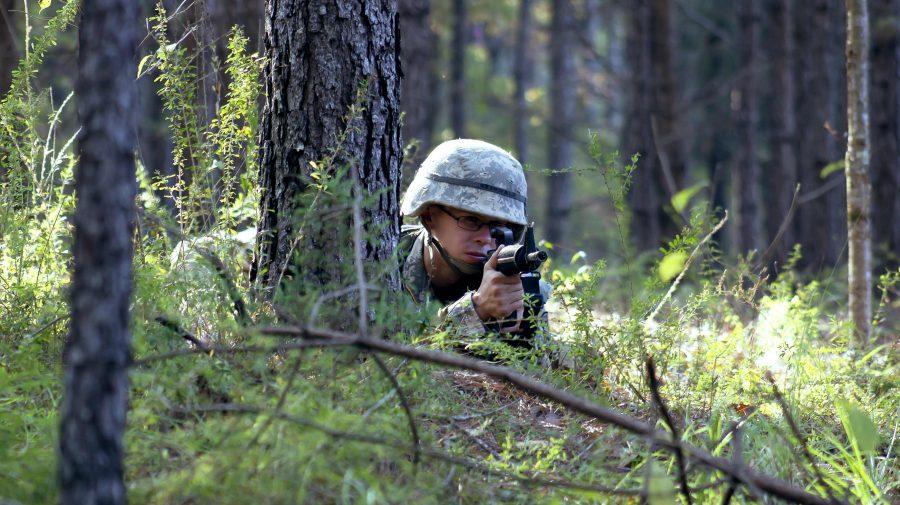It’s 6 a.m., and they’ve already been running for 15 minutes. Sprint for 30 seconds, rest for 60 seconds, repeat 20 times. Abdominal exercises, push-ups, sit-ups, pull-ups.
Monday, Tuesday and Thursday of every week, members of The University of Alabama Army ROTC program are divided into groups based on age and athleticism on the University Recreation fields at the break of dawn, and training ensues for over an hour. Strength and stamina are assessed, and the cadets are pushed to the limit.
“The cadets are here at the University for a degree,” Sgt. 1st Class Davis said. “But we are trying to build a foundation for physical training and a base knowledge for a military career. They are more or less the same as athletes with classes and training.”
Established in 1860 as a disciplinary initiative to counter behavioral problems of University students, the battalion is one of only three Corps of Cadets across the country to have participated in the Civil War. During the Civil War, the corps gathered to defend the University from Union troops, and the Little Round House adjacent to Gorgas Library served as a guard post, Davis said.
Currently, the battalion holds 171 enrolled cadets, both in the basic and the advanced courses. The basic course allows freshman and sophomore students to learn the duties and responsibilities of a military leader with no military obligation. However, the advanced track prepares juniors, seniors and graduate students for four to six years of active duty or service in the United States Army National Guard or Army Reserve.
“You never know what you’re going to do,” Davis said. “You never know the terrain you’re going to have to be in. In Afghanistan, the elevation of the mountains and the thinness of the air is a lot different than the deserts of Iraq. You’re generally carrying about 100 pounds of gear. That’s why we do physical training — to get them at the base of fitness. At 7,000-8,000 feet in the mountains of Afghanistan, you need that.”
Every Wednesday afternoon, cadets also travel to Cottondale, Ala., for a two-hour lab session that teaches movement in a formation, marching, weapons techniques and STX lane training, a timed mission that mimics real-life combat and allows practice of communication and navigation skills. Squad leaders are assigned and rotated each day, and they are graded on a leadership assessment form that evaluates many factors of performance, such as mental agility and leadership.
“It adds an aspect of realism — to get off of campus and into the woods,” Peter Ingram, a senior majoring in economics and Spanish, said. “You have to handle a lot of things, so if you don’t know what you’re doing, it can go really bad. It’s where the practice comes in. The better you perform here, the better you perform in the Leadership Development and Assessment Course before your senior year, the better you place on the Order of Merit List, and the better your job placement. It’s pretty much like any job: Excellence gets rewarded.”
The Order of Merit List, a weighted ranking system that includes GPA, physical fitness and extracurriculars, compiles the top cadets in the battalion and selects the top two seniors as battalion commanders. Christina Jones, a senior majoring in French, was chosen as battalion commander for the fall academic semester, making her the first female to ever serve as commander of the UA battalion.
Jones, who comes from a rich military background, finds a space for herself within the male-dominated field.
“It’s really cool to be able to say that I was the first female, but it’s even better to say that I’m a battalion commander at The University of Alabama,” Jones said. “Being the first female, it’s great being able to say that you made that milestone. But honestly, even being the first, just being a battalion commander here proves that all the hard work and all the long hours and all the early mornings were worth it.
“At first it was really weird to get used to. I have an older brother, and I hung out with all his friends growing up, so I was used to being around guys but definitely not to the extent that you do in the ROTC. You get very comfortable with each other. I have about 150 brothers now. It’s just a really neat camaraderie you have. It’s definitely difficult at times because they don’t know the boundaries that females have whenever they’re talking about certain things. They will still be guys, and you just have to get used to that.”
Jones created herself as an example for females in the battalion who strive to be a leader.
“It can be a little harder,” said Christine Baker, a senior majoring in psychology and the public affairs officer. “Sometimes you get a little disrespected, but that’s just when you have to put on your rucksack and do the best you can. And sometimes even better.”







